Evolution
Prior to the 1990s, the Bornean and Sumatran orangutans were cIassified as sub-species; genetic evidence (derived from sequencing of mitochondrial DNA) proved that they are in fact two separate species: Pongo pygmaeus and Pongo abelii, respectively. The evolutionary split took place as recently as 1.5 million years ago - considerably more recently than the divergence of humans and chimpanzees which took place approximately 5.5 million years ago.
There are three agreed sub-species of Bornean orangutan:
- The northwest Bornean orangutan (P.p.pygmaeus) -
found in Sarawak and northwestern Kalimantan - The central Bornean orangutan (P.p.wurmbii) -
found in Southwestern and central Kalimantan - The northeast Bornean orangutan (P.p.morio) -
found in East Kalimantan and Sabah
Although the two species of orangutans diverged just over one million years ago, the Sumatran and Bornean orangutans were still considered two subspecies of the same species right up until the late 1990's. Even now, there is confusion and disagreement with the classification of the Bornean orangutan, with there being three (and possible four) distinct subspecies, which split some 860,000 years ago (Bradon-Jones et al. 2004). Some researchers have posited that one of the Bornean sub-species (P.p.wumbrii) is actually more-closely related to the Sumatran orangutan than the Bornean orangutan, which (if true) would further confuse and potentially-complicate research and conservation management.
Breeding & Life History
These long-lived primates have a life history, where females reach sexual maturity at between 11-15 years old and males face the transition from adolescence to adulthood at between 7-10 years, although this can be as young as six and a half years in captivity.
Females reach sexual maturity at approximately 11-15 years in the wild, although maturation can occur as early as 7-9 years in captivity. Sexual maturation in males ranges broadly. Males have been known to father offspring as early as 6.5 years in captivity. As young orangutans mature, their faces turn from a pale pink to a dark brown or black. Full sexual maturity in males may take up to a further ten years. Orangutans have an inter-birth interval of 8-9 years - the longest of any terrestrial mammal. The young are nursed for an approximate six years, during which time sexual hormone production in the adult female appears to be suppressed.
Gestation in both species of orangutan is approximately eight months and like humans (and unlike chimpanzees), orangutan females do not display large oestrous swellings in relation to their 28 day reproductive cycles to indicate receptiveness. Currently, there is still debate as to whether orangutans experience a menopause and evidence exists for both arguments. Many matings are termed as 'forced copulations', where males coerce females into mating. It has been observed that more mating behaviour occurs during periods of high fruit availability. This appears to have the physical effect of an increase in oestrogen levels in females.
Although typically known for their solitary (and almost anti-social) behaviour, brief pairings between males and females often occur after mating. These pairings may last from a few days up to a period of several months and are often accompanied by the females existing infant or juvenile.
Photographs kindly provided by David Slater, Nick Bramley, STA
For information on deforestation and habitat loss, please CLICK HERE
Bornean orangutan (Pongo pygmaeus) orang-utan ape facts - evolution breeding life history - Borneo Sabah South East Asia - Wildlife Holiday Responsible Travel





.jpg)

